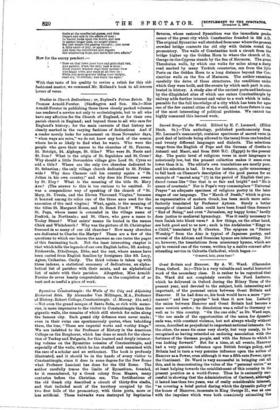Byzantine Constantinople: the Walls of the City anti Adjoining Historical
Sites. By Alexander Van Millingen, M.A., Professor of History, Robert College, Constantinople. (J. Murray. 21s. net.) —Not even the grand mosque of Santa Sofia, so rich with memo- ries, is more impressive to the visitor to Constantinople than the gigantic walls, the remains of which still stretch for miles along the famous city. Such grand city defences were never made ; even in their ruins one spontaneously quotes,, when beholding them, the line, "These are imperial works and worthy kings." We are indebted to the Professor of History in the American College on the Bosphorus, which has done so much for the eleva- tion of Turkey and Bulgaria, for this learned and deeply interest- ing volume on the Byzantine remains of Constantinople, and especially of the walls, which he has studied and examined with the care of a scholar and an enthusiast. The book is profusely illustrated, and it .should be in the hands of every visitor to Constantinople, since it does in some degree for the New Rome what Professor Lanciani has done for the Old Rome. The author carefully traces the limits of Byzantium, founded, be it remembered, by a Greek colony from Megara, many centuries before the Christian era. The fortifications of the old Greek city described a circuit of thirty-five .stadia, and that included most of the territory occupied by the two first hills of the promontory, with three ports, more or less artificial. These bulwarks were destroyed by Septimius Severus, whose restored Byzantium was the immediate prede. cessor of the great city which Constantine founded in 328 A.D. The original Byzantine wall stretched from near where the present crowded bridge connects the old city with Galata round the promontory. The walls of Constantine took a circuit from the bridge higher up the Golden Horn to where the church of St. George-in-the-Cypress stands by the Sea of Marmora. The great Theodosian walls, by which one walks for miles along a dusty road marked by many Turkish cemeteries, ran from the Zylo Ports on the Golden Horn to a long distance beyond the Con- stantine walls on the Sea of Marmora. The auth-or examines carefully the dates of these structures, the conditions under which they were built, and the events by which each part is cele- brated in history. A study also of the ancient ports and harbours by the dilapidated sites of which one enters Constantinople by railway adds further interest and value to a work which is indis- pensable for the full knowledge of a city which has been for ages one of the few central cities of the world, and whose future is one of the most interesting of political problems. We cannot too highly commend this learned work.






















































 Previous page
Previous page